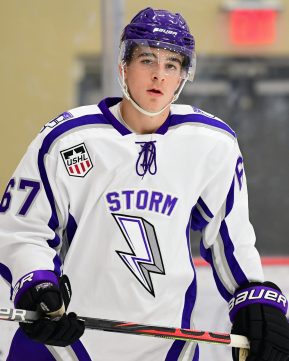The native of Welland, Ontario has made gigantic strides between his first year and his second with the Tri-City Storm. A smaller forward, Colby Ambrosio won’t turn 18 until August, hinting that he may have more room for growth than most in this draft class. The fact is he will need to grow some to continue to play his brave skill game. The Boston College commit has high end hands and can pull something out of nothing at the smallest of opportunities.
A gifted goal scorer, Ambrosio has a knack for putting himself in a position to succeed. There may be some question as to whether he can push the pace without skilled linemates going forward, but he makes things happen more than many. This is a player for whom the pros far outweigh the cons and he has top six upside, albeit not without risk.
| Colby Ambrosio | 2020 NHL Draft Eligible |
|---|---|
| Position: C, Shoots R | H/W: 5-9", 165 lbs |
| Stats to date (GP-G-A-PTS-PIMS) | Tri-City Storm, USHL (48-26-24-50-54) |

Colby Ambrosio. Photo by Dan Hickling, Hickling Images
Skating: A solid skater with sharp edges, Ambrosio’s skating pays to its potential as he always keeps his feet in motion. He is not a blazer, but his top speed is decent. More than many, his skating grade is a functiuon of his feet as much as his legs. He spots an area he needs to possess and moves – forwareds, backwards, or laterally – to that spot. He can slip into open ice to cerate havoc due to that factor. Grade: 50
Shot: Ambrosio has a nice, hard shot. A volume shooter, he would do well to consider shot selection more carefully going forward, but his wrist shot is powerful and whippy and he can pick a spot (top shelf) from in tight. A lot of his shot is a function of having very good hands that enable to release from odd angles, little room to maneuver and even less time. Also very comfortable playing in the Ovechkin spot, from where he can capitalize. Grade: 55
Skills: Whenever Ambrosio handles the puck, the quality and skill in his hands is apparent. He will usually play simple, but will occasionally change things up for a dangle to make a defender – or a goalie – look silly. He will lead the cycle and can deke his way into the clear against most defenders at this level. His hands in tight are among the best in the USHL this season. I think of one goal he scored when he received the puck just to the left of the crease. He moved his body further left and shifted his hands to the right, getting the goalie to go into the butterfly, whereupon Ambrosio snapped the puck into the far side top corner. Or I think of another game, with Ambrosio rushing in towards the net on a two-on-one, with a defender to his right. Ambrosio deked in, the defender bit slightly, Ambrosio put the puck between his own legs and he walked around the defender and in on the goalie. He can do things that not many others can. Grade: 60
Smarts: Ambrosio wants the puck. He has a knack for getting himself open in dangerous areas. Away from the puck, he is solid, sticking to his assignment and role. He reads the ice well and makes smart decisions in accordance. He can be quite dogged in pursuit of the puck. He uses his stick well to force turnovers. I would like to see him push the offense into the more dangerous areas for scoring chances more often. He can do it, but does not always jump at the chance. Grade: 55
Physicality: Although undersized, Ambrosio plays with enough grit for the stature not to work against him too much. He isn’t shy about traffic. He is willing to take a hit to make a play. He is often the F1 on the forecheck and he finishes his checks, although he lacks the presence for those checks to be of any real significance. I suspect he will have to play a little safer going forward. Grade: 45
Overall Future Projection (OFP): 54.25
A note on the 20-80 scale used above. We look at five attributes (skating, shooting, puck skills, hockey IQ and physicality) for skaters and six for goalies (athleticism/quickness, compete/temperament, vision/play reading, technique/style, rebound control and puck handling). Each individual attribute is graded along the 20-80 scales, which includes half-grades. The idea is that a projection of 50 in a given attribute meant that our observer believed that the player could get to roughly NHL average at that attribute at maturity.